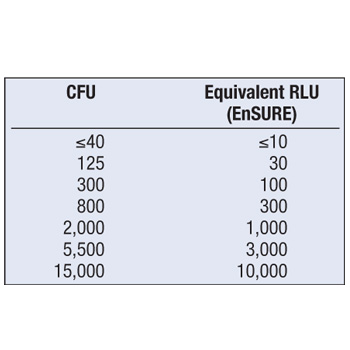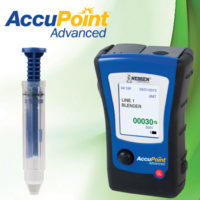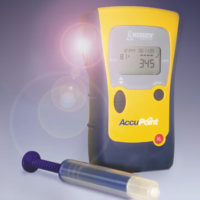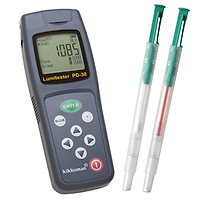Next Generation ATP Systems: More than Sanitation Monitoring

Several industrial applications of adenosine triphosphate (ATP) bioluminescence have been developed since the late 1970s. These largely non-specific applications have been used for the direct objective assessment of cleaning verification and gross monitoring of microbial biomass. Significant developments have been made over the past 10 years. Recent improvements in reagents and instrumentation have led to the first specific test application for the detection of low numbers of pathogenic and indicator organisms within a single working day.
Traditional ATP bioluminescence is very rapid and very sensitive. However, ATP is a universal energy molecule that is abundant in most organic materials, and these tests cannot differentiate ATP from specific sources.
The most widely used application of ATP bioluminescence is surface sanitation monitoring, which provides a direct objective test for cleaning verification. This application is a test for residual organic matter and is not intended to replace bacterial culture tests. Facilities doing both ATP monitoring and bacterial testing can obtain real-time readings of the general sanitation level and confirm results within 24 to 72 hours with bacterial culture tests. The wait time between ATP and culture tests leaves room for improvement; food and beverage processors would like to have bacterial test results sooner so that corrective actions can be taken earlier.
Next Generation Rapid Microorganism Tests
A novel reagent technology now bridges the time gap between ATP results and bacterial culture tests, putting both tests in one easy-to-use system. Hygiena has created a new platform called MicroSnap that can detect coliform, Escherichia coli and aerobic plate counts (APC) in less than 8 hours. By designing one system that can do both ATP sanitation monitoring and the most common environmental indicator organism tests, food and beverage processors now have the ability to acquire an accurate status of plant hygiene during the same working day or shift. This allows for corrective actions to take place on the spot versus the following day.
Easy-To-Use and Simplified For Any User
The MicroSnap system consists of two easy-to-use components: device 1: a sample collection and enrichment device, and device 2: an end-detection device.
Device 1 is fitted with a swab for testing surfaces, such as carcasses, but can also be used for product testing. After collecting or adding the sample, the device is activated to mix the sample with the enrichment broth. The whole device is then incubated up to 7 hours at 37 °C, depending on the colony-forming unit (CFU) pass/fail thresholds. Higher CFU thresholds require less incubation, shortening the time to results. At the desired time points, 0.1 mL enrichment culture is transferred to device 2, which is then activated and incubated for 10 minutes at 37 °C and then placed in the EnSURE luminometer, generating results in 15 seconds. In presence/absence testing (1–5 CFU), a result greater than 10 relative light units (RLU) is considered positive. For different CFU pass/fail thresholds, a chart is provided that shows the corresponding RLU value to CFU level at 6 hours of incubation. This speeds time to results for facilities with CFU thresholds of 40 CFU or greater. For example, a facility with a 100 CFU coliform threshold would incubate for 6 hours; a result of 30 RLU or higher would indicate a fail.
Better Performance than Traditional Bacterial Culture Tests
MicroSnap has been independently verified by leading food safety and quality laboratories and shown to have a sensitivity of 89% and a specificity of 99%, which are better than traditional culture methods. AOAC INTERNATIONAL approval is expected in the latter part of 2012, but the product is being widely used by food and beverage processors today. For low numbers of organisms (1–5 CFU), the detection time was confirmed at 7 hours both in pure culture and inoculated foodstuffs. The traditional bacterial culture method detected 95% of samples, whereas MicroSnap detected 99% of samples.
The specification for coliforms and E. coli in many industrial applications is less than 10 CFU/g, which is effectively a presence/absence test for a 1:10 dilution of a solid sample (i.e., < 1 colony per plate). Hence, MicroSnap gives equivalent results to the traditional method but in a fraction of the time.
With the new MicroSnap test platform combined with the leading ATP sanitation monitoring system, food and beverage processors have the ability to use a single system to get an accurate and precise picture of the facility’s microbial environment in 8 hours or less, sanitation verification in 15 seconds and the ability to release product sooner if hold requirements are based on coliform, E. coli or APC results.
hygiena.net
Looking for a reprint of this article?
From high-res PDFs to custom plaques, order your copy today!








